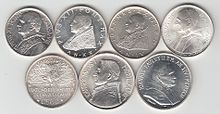Vatican lira
| Vatican lira | |
|---|---|
| Country: |
|
| Subdivision: | 100 centesimi |
| ISO 4217 code : | VAL |
| Abbreviation: | ₤, L. or £ |
|
Exchange rate : (fixed) |
1 EUR = 1936.27 VAL |
The Vatican Lira (" pound ", hence the currency symbol £ , ISO code VAL) was the official currency in Vatican City until December 31, 2001 .
history
The images of the popes have been depicted on coins for well over 1000 years. As a secular ruler, the Pope regularly issued coins. These were issued in the various currencies then ruling denar , florin , ducat , doppia and scudo until the lira was introduced in 1866. The Papal States used since 1866, the lira, according to the norms of the Latin Monetary Union was pronounced before the Papal States by Italian troops occupied and was disbanded 1870th
In 1929, with the signing of the Lateran Treaty, the Vatican City was founded, which according to the provisions of the treaty had the right to import its own coins. The Vatican Lira was linked to the Italian Lira and divided into 100 Centesimi. Italian and San Marino coins and banknotes were also accepted as means of payment in Vatican City. Conversely, the Vatican coins, which were minted in the Italian state mint, Istituto Poligrafico e Zecca dello Stato in Rome , were means of payment in Italy and in San Marino .
In 2002 Vatican City introduced the euro. The exchange rate was 1 euro = 1936.27 lira. Since then, Vatican City has had its own euro coins minted.
Coins

In 1929 5 and 10 centesimi coins made of copper , 20 and 50 centesimi coins, 1 and 2 lire coins made of nickel and 5 and 10 lire coins made of silver were introduced. There was also a 100 lire gold coin . In 1939, aluminum-bronze replaced copper coins and in 1940 nickel coins were replaced by steel. Between 1941 and 1946, only a few thousand pieces of the denominations mentioned were minted.
Vatican City introduced new aluminum coins in 1947 : 1, 2, 5 and 10 lire. The size of these coins was reduced in 1951 and new 50 and 100 lire coins made of steel were introduced in 1955 . This was followed in 1957 by a 20 lire piece made of aluminum-bronze and in 1958 a 500 lire piece made of silver. The production of the 1 and 2 lire coins was discontinued in 1977, that of the 5 lire coins in 1978. Instead, 200 lire pieces made of aluminum-bronze and 1000 lire pieces made of silver were introduced in 1978, followed by one in 1982 500 lire bimetal piece and 1997 from a 1000 lire bimetal piece. In addition, silver commemorative coins were minted at 2000, 5000 and 10,000 lire.
The 100 lire gold coins were minted continuously from 1929 to 1959. From 1996 commemorative gold coins were issued for 50,000 and 100,000 lire.
literature
- René Frank : The 100 lire coins of the Vatican - gold coins even during the Second World War . In: Money Trend 05/2008, pp. 148–152.
Individual evidence
- ↑ Heinz Brestel (Ed.): Yearbook for Capital Investors 1999 , p. 68.
- ↑ Florian Schön: Vatican Coin Catalog , 2015
